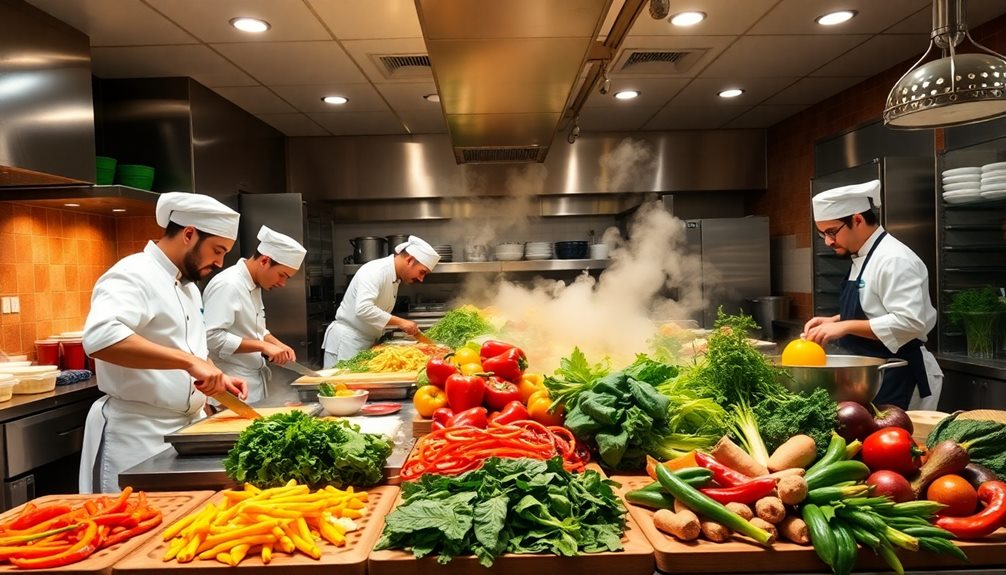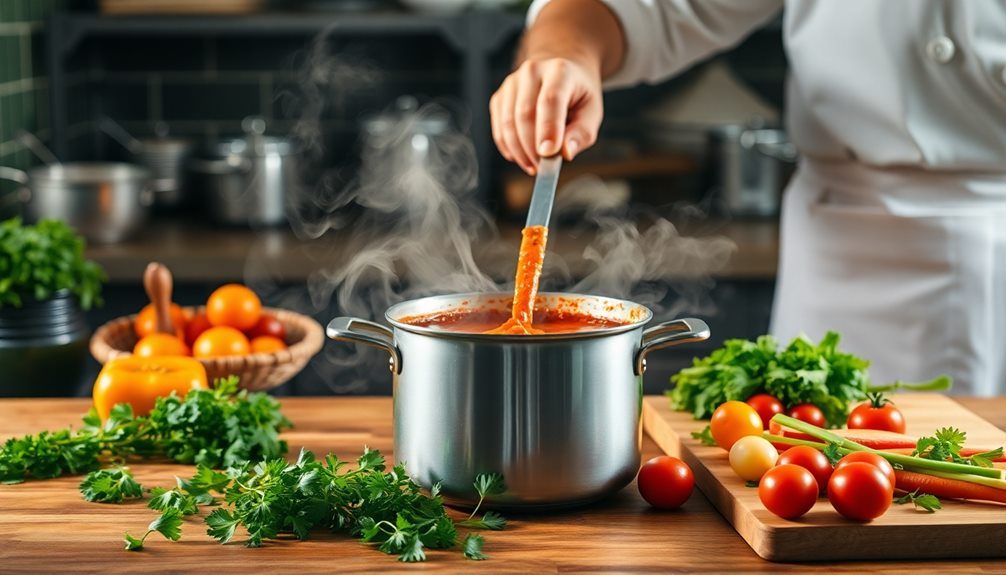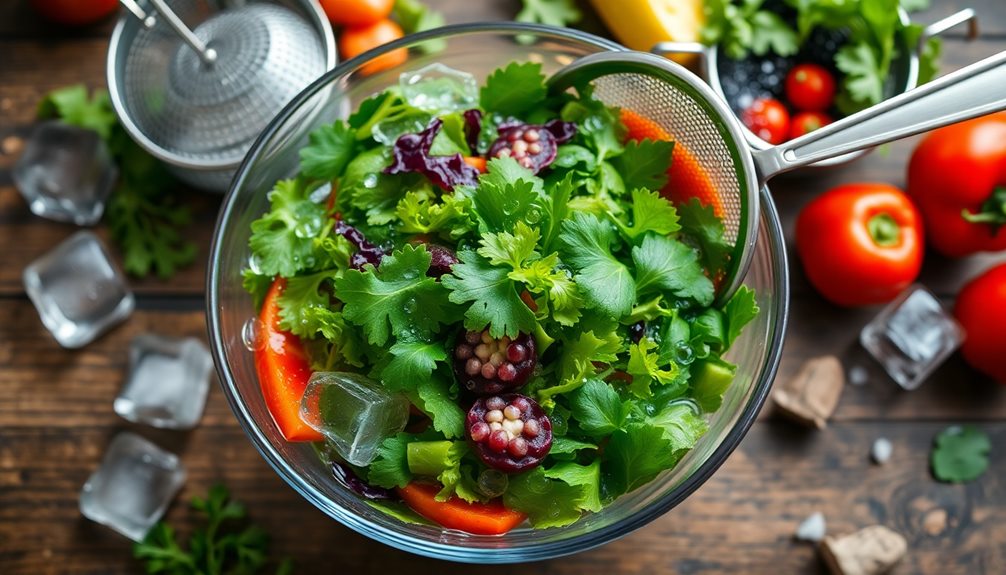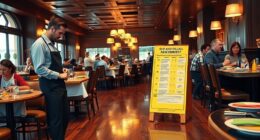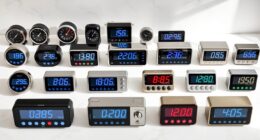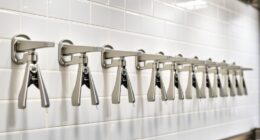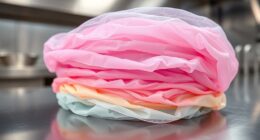Restaurants maintain food temperature by using specialized equipment like warming ovens and refrigerators. They keep hot foods at a minimum of 135°F and cold foods below 41°F to prevent bacteria growth. Regular temperature monitoring is essential, with staff checking food temperatures frequently using calibrated thermometers. Rapid cooling techniques are employed when needed, guaranteeing safe temperatures. Staff training guarantees everyone understands safe handling and temperature control practices. This combination of effective equipment and trained personnel helps keep food safe and delicious. If you're curious about the specific tools and techniques used, you'll find even more helpful insights ahead.
Key Takeaways
- Restaurants keep hot foods above 135°F using warming ovens, steam tables, and holding cabinets to prevent bacterial growth.
- Cold foods are stored at or below 41°F in refrigerators and insulated containers to avoid spoilage during transport.
- Regular temperature monitoring with calibrated thermometers ensures compliance with safety standards and prevents foodborne illnesses.
- Rapid cooling methods are employed to quickly bring food from 140°F to 70°F, minimizing bacterial growth.
- Employee training on safe handling practices and temperature control is essential for maintaining food safety and quality.
Importance of Food Temperature Control
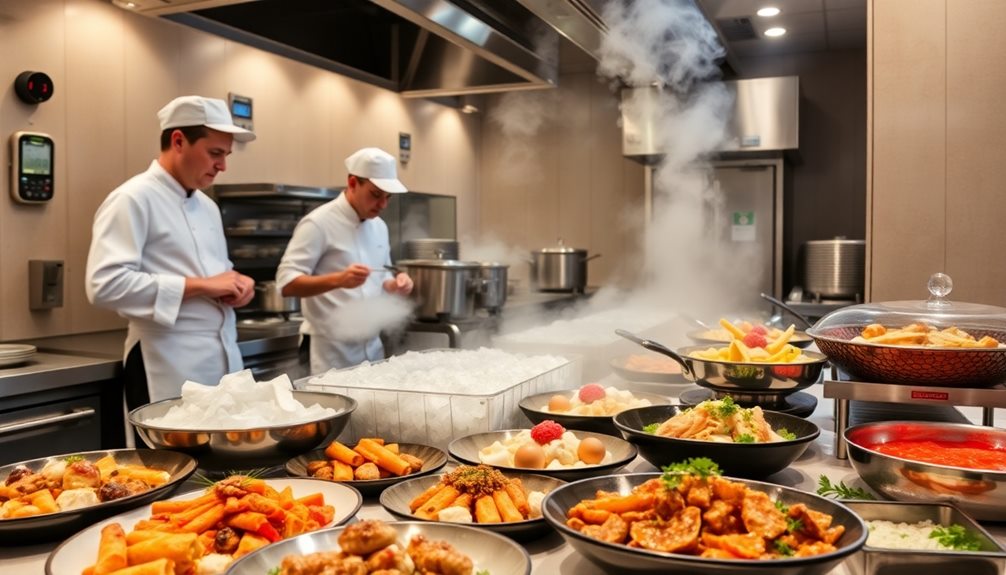
Maintaining food temperature is essential for both safety and quality in restaurants. You need to keep food out of the danger zone, which lies between 41°F and 135°F. Hot foods should always be held at a minimum of 135°F to guarantee safe temperatures, while cold foods must stay at 41°F or below. This isn't just about following regulations; it directly impacts your customers' health.
Rapidly cooling hot foods from 140°F to 70°F within two hours, and then down to 41°F in an additional four hours, is vital to minimize bacterial growth.
Effective temperature monitoring is key in this process. Using calibrated thermometers and temperature monitoring systems helps you confirm compliance with food safety standards. By regularly checking food temperatures, you can prevent the risk of foodborne illnesses and maintain the quality and flavor of your dishes.
Equipment for Hot Food Maintenance
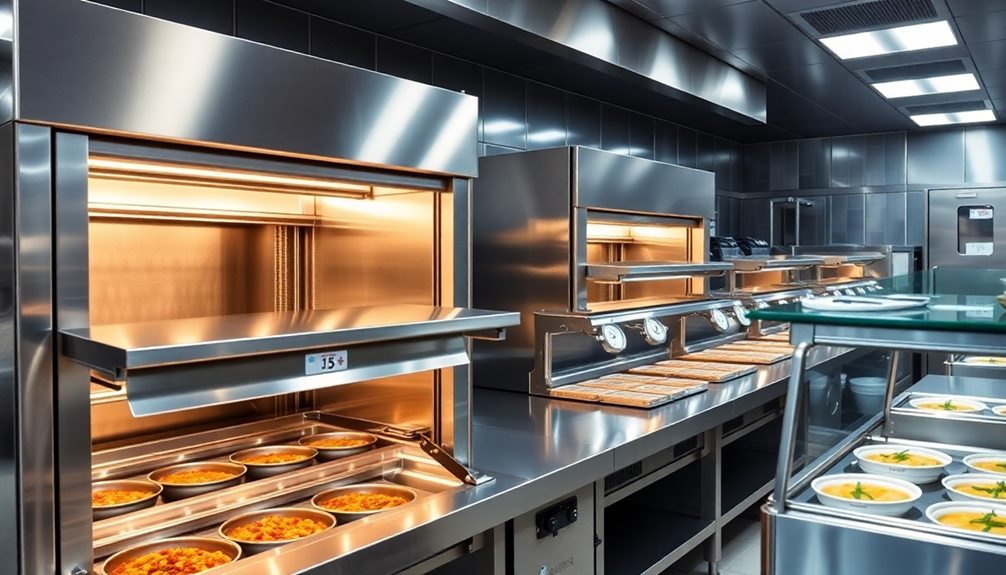
How can you guarantee that hot food stays at safe temperatures in your restaurant? Investing in the right equipment is essential for maintaining food safety.
Warming ovens are a reliable choice, keeping dishes like vegetables and rice at a minimum of 135°F to ascertain they're safe for serving. For self-service options, consider steam tables; they keep pre-cooked food warm and visible, effectively raising temperatures to safe levels for immediate consumption.
If you need to store extra food until it's time to serve, holding cabinets are ideal. They maintain temperatures above 140°F, preventing bacterial growth and ascertaining your food stays safe.
When it comes to buffets and catering, chafing dishes are a popular option. They utilize a heat source beneath to keep food at proper temperatures while allowing for easy serving.
Lastly, cook and hold ovens are invaluable as they cook food to the desired temperature and maintain it without overcooking. This ascertains consistent quality and safety, making them a must-have for any food service operation.
With the right equipment, you can confidently serve hot food that's safe and delicious.
Techniques for Keeping Food Warm
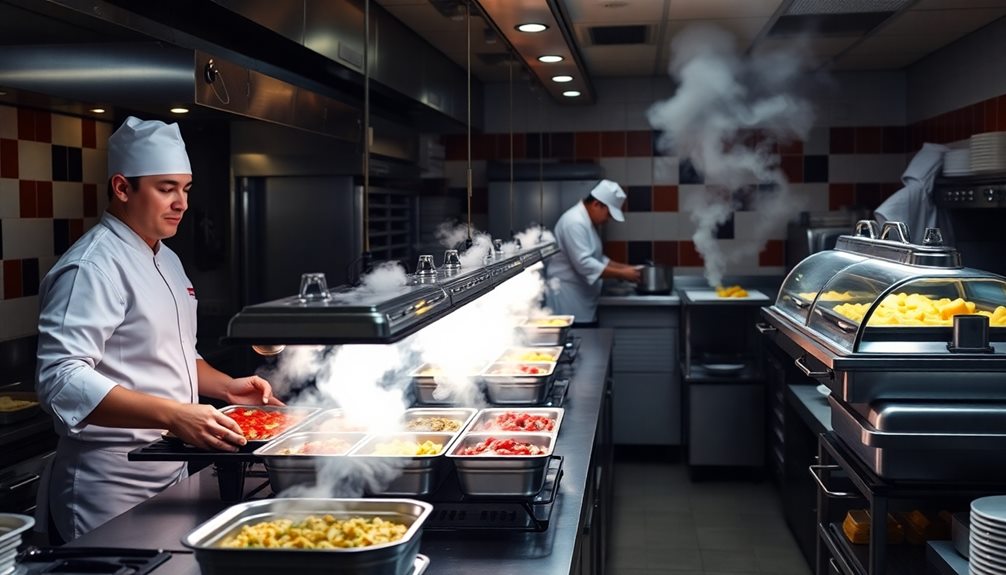
When it comes to keeping food warm, you'll want to focus on the right equipment and techniques that guarantee safety and quality.
Using catering warmers or steam tables can help maintain ideal temperatures, while methods like frequent stirring prevent cold spots.
It's essential to keep foods above 140°F to avoid foodborne illnesses, so let's explore effective strategies for temperature control.
Equipment for Maintaining Heat
To keep food at safe temperatures, restaurants rely on various specialized equipment designed for warmth retention. Warming ovens are vital for maintaining hot foods hot, guaranteeing that items like vegetables and rice stay at a safe holding temperature of 135°F or above. This is essential for food safety, as it helps prevent foodborne illness.
Round warmers work wonders for soups and liquids, and they're versatile enough to melt cheese without losing heat. Drawer warmers offer controlled moisture levels, making them perfect for keeping rolls and tortillas warm without drying them out.
For events and buffets, portable catering warmers powered by chafing dish fuel can maintain the proper temperature of foods for several hours. This guarantees that your guests enjoy safe, delicious meals.
It's also important to stir thick soups, stews, and gravies frequently in hot holding units, as this promotes even heat distribution and keeps food safety standards above 140°F.
Event Food Warmer Techniques
Keeping food warm during events requires effective techniques to guarantee safety and quality. Catering warmers powered by chafing dish fuel are perfect for maintaining heat for several hours, ensuring your cooked foods stay at safe temperatures.
Similarly, steam tables are widely used for pre-cooked food, keeping temperatures above 140°F, which is essential for hot holding and food safety.
For cold foods that need reheating, consider using rethermalizers. They quickly heat items to the proper holding temperatures, ensuring every dish is served with the right temperature for best safety and quality.
When using hot holding units, remember to frequently stir thick soups, stews, and gravies to promote even heat distribution and avoid any temperature drops.
It's important to monitor the temperature regularly, as any food held below 140°F should be discarded after a few hours to minimize the risk of foodborne illnesses.
Importance of Temperature Control
Maintaining the right temperature for food is essential in any restaurant setting, as it directly impacts both safety and flavor. To guarantee your hot foods stay delicious and safe, you need effective temperature control. Keep those dishes at 135°F or above to prevent foodborne illnesses and preserve their taste.
Using catering warmers and steam tables can help you maintain pre-cooked foods at safe temperatures, ideally above 140°F. It's also important to frequently stir thick soups and stews in hot holding units; this promotes even heat distribution and prevents any temperature drop.
Holding cabinets and food warmer containers are invaluable tools for storing extra food until it's time to serve. These setups help maintain the desired internal temperature, guaranteeing quality throughout your service.
Strategies for Keeping Food Cold
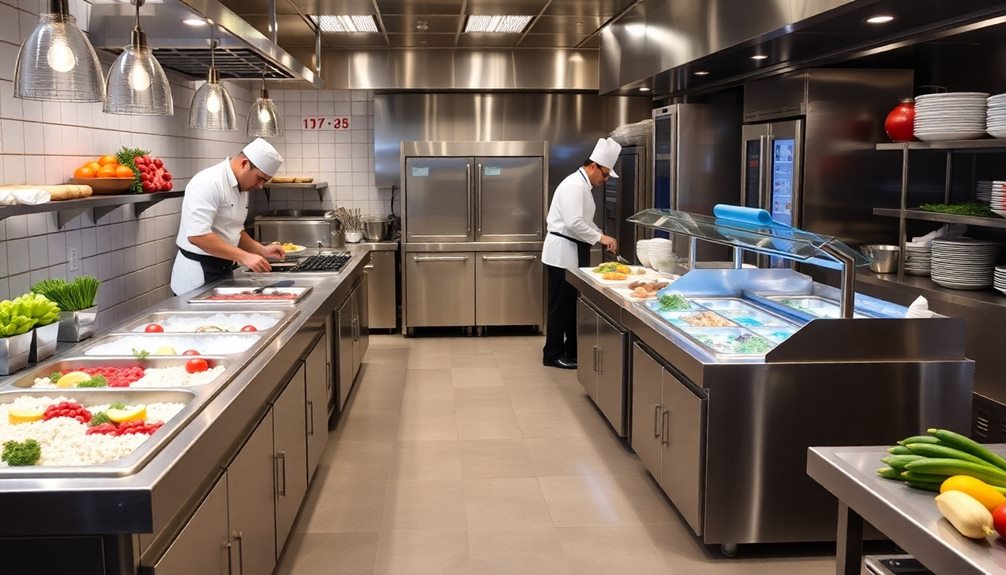
How can restaurants effectively guarantee that cold food remains at safe temperatures? To start, they rely on refrigerators and freezers, making certain these units operate at 40°F or below for refrigerated items and 0°F or below for frozen items. This helps prevent bacterial growth, keeping your cold foods safe.
When it comes to serving, restaurants often utilize cold and ice buffets. Insulated wells keep items like salads and cold meats chilled, while cold chafing dishes filled with ice and water maintain temperatures at or below 41°F. This is fundamental for food safety, especially for seafood and salads.
For transporting chilled items, catering coolers and insulated containers play an important role. These containers maintain cold temperatures for hours, particularly for sensitive items like meat and seafood, making sure they arrive safely at your table or event.
Lastly, temperature monitoring is essential. Designated staff regularly check temperatures upon delivery and throughout service to verify compliance with food safety standards.
Monitoring Food Temperatures
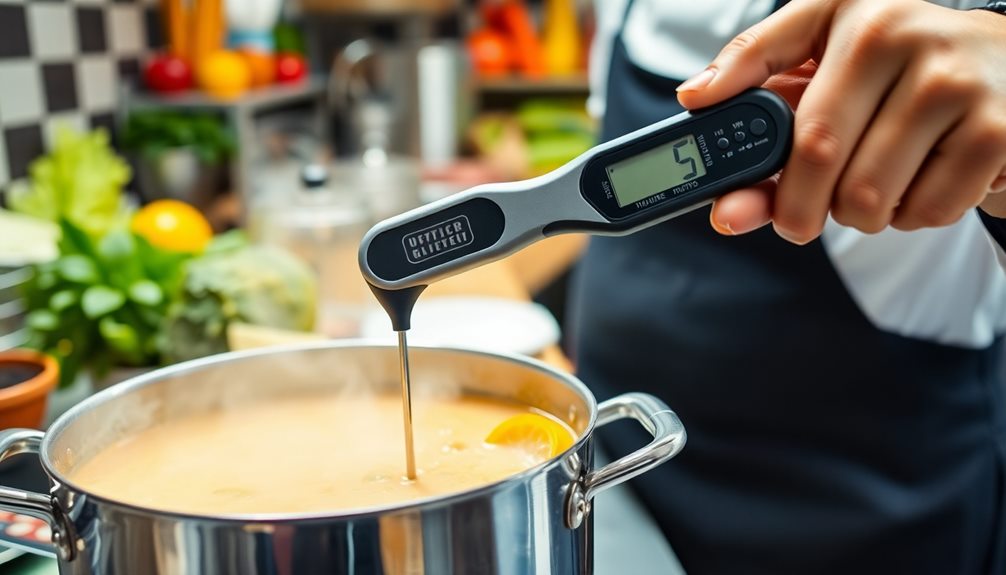
Regular monitoring of food temperatures is essential for ensuring safety in restaurants. To keep your food safe, you need to monitor food temperatures regularly, making sure they stay out of the danger zone between 41°F and 140°F.
Designated employees should use a thermometer to check refrigerator temperatures at or below 40°F and freezer temperatures at or below 0°F at least three times a day: when opening, mid-shift, and at closing.
To achieve accurate readings, calibrate food thermometers weekly using ice water, ensuring they read 32°F or 0°C. Remember to sanitize the thermometer before and after each use to prevent cross-contamination.
When checking food temperatures, insert the thermometer into the thickest part of the food, allowing it to stabilize for five minutes for a reliable reading.
Creating and posting a temperature monitoring schedule for various food types not only promotes accountability but also helps maintain compliance with safety standards.
Employee Training for Safety
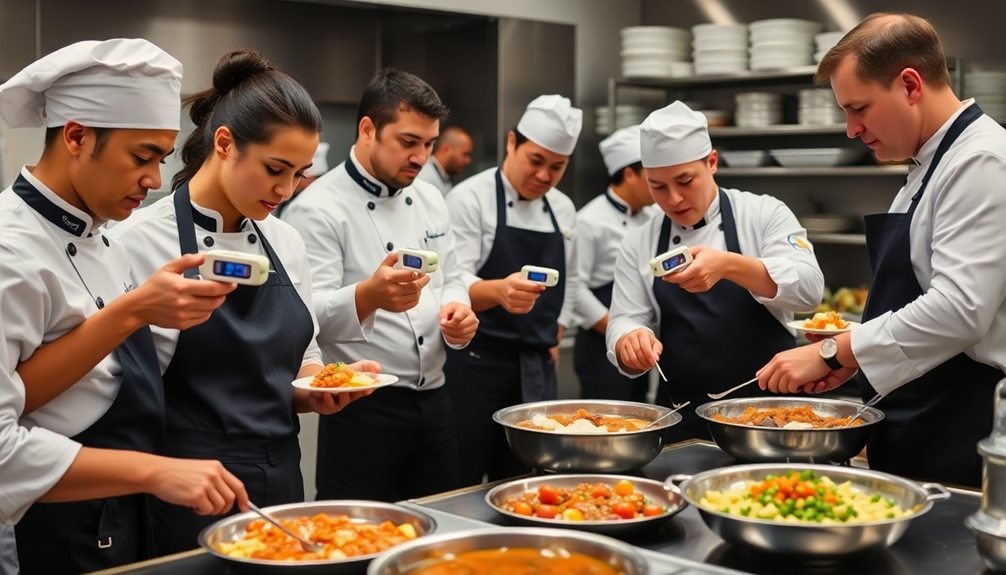
To guarantee food safety, you need to prioritize employee training on temperature monitoring.
Proper thermometer usage and understanding safe food handling practices are essential in preventing foodborne illnesses.
Importance of Temperature Monitoring
Effective temperature monitoring in restaurants is essential for guaranteeing food safety, and proper employee training plays a key role in this process. By educating staff about the importance of maintaining temperatures, you help minimize risks associated with the danger zone (41°F to 140°F), where harmful bacteria can thrive.
Here are some key training points to focus on:
- Calibrated Thermometers: Guarantee employees understand how to use and calibrate thermometers for accurate readings.
- Temperature Danger Zone: Teach staff the risks of holding cooked food within the danger zone.
- Accountability: Assign temperature monitoring tasks to multiple team members to foster a culture of safety.
- Rapid Cooling Procedures: Regularly train on proper cooling methods, like cooling food from 140°F to 70°F within 2 hours.
- Backup Thermometers: Provide access to standard thermometers for consistent monitoring accuracy.
Proper Thermometer Usage
Proper thermometer usage is crucial for ensuring food safety in your restaurant. To maintain proper food temperatures, you need to train your employees on the correct usage of food thermometers. Remember, color is not a reliable indicator of doneness, so accurate readings are critical.
Make sure your staff checks and calibrates digital thermometer probes weekly, targeting a reading of 32°F (0°C) using ice water. When measuring temperature, it's essential to insert the thermometer into the thickest part of the food and wait five minutes for an accurate reading. Additionally, thermometers must be sanitized before and after each use to prevent cross-contamination.
To streamline temperature monitoring, consider implementing a schedule for various food types while assigning specific tasks to multiple staff members. This not only boosts accountability but also compliance with safety standards.
Here's a quick reference table to assist your staff:
| Task | Frequency | Responsible Staff |
|---|---|---|
| Calibrate Thermometers | Weekly | Kitchen Staff |
| Check Food Temperatures | Every 2 hours | Line Cooks |
| Sanitize Thermometers | Every use | All Staff |
| Log Temperature Readings | Daily | Shift Supervisor |
| Review Temperature Logs | Weekly | Manager |
Safe Food Handling Practices
Safe food handling practices are essential for maintaining health and safety standards in your restaurant. To prevent bacterial growth, you need to train your employees to recognize and monitor the temperature danger zone, which is 41°F to 140°F.
Everyone must understand that food must be held at safe temperatures: hot foods above 140°F and cold foods below 41°F.
Here are some key practices to reinforce:
- Rapidly cool cooked food from 140°F to 70°F within 2 hours.
- Continue cooling to 41°F within an additional 4 hours.
- Teach proper thermometer usage and calibration for accurate readings.
- Conduct regular training sessions to emphasize safe food handling.
- Assign temperature monitoring tasks to multiple employees for accountability.
Best Practices for Food Handling
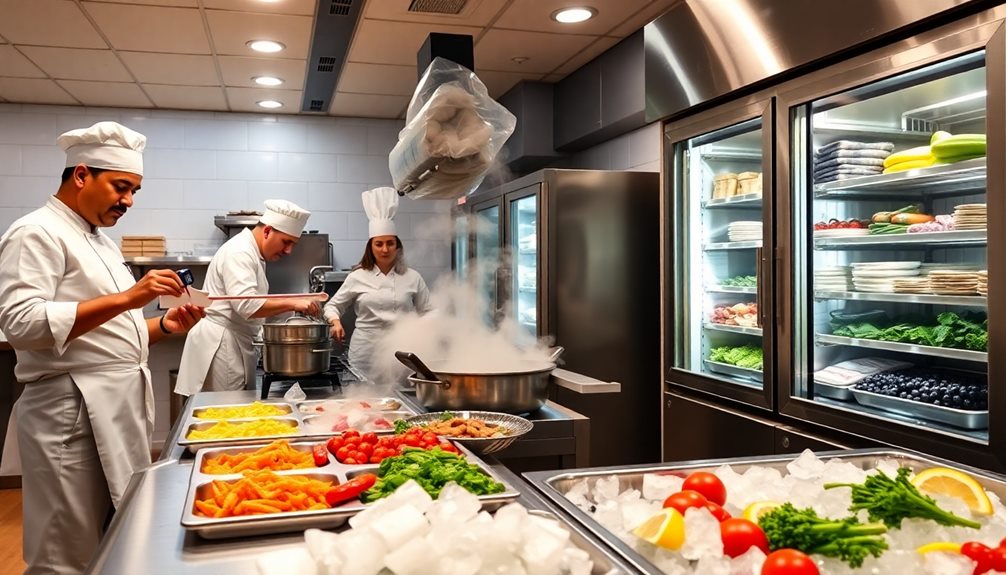
Maintaining food safety in restaurants hinges on a few key practices that every staff member should know. First, always keep hot foods at a minimum temperature of 135°F. This practice is essential to prevent bacterial growth and guarantee the food remains safe for customers.
For cold foods, remember to store them at 41°F or below, adhering to FDA standards to minimize the risk of foodborne illnesses.
When cooling food, use rapid cooling techniques. You should aim to drop temperatures from 140°F to 70°F within 2 hours, followed by reducing it further to 41°F in an additional 4 hours. This method is critical for safe food handling.
Regular temperature monitoring is significant. Check the temperatures of your refrigerators and freezers at the beginning, middle, and end of shifts. This helps you stay compliant with safety standards.
Frequently Asked Questions
How Do Commercial Kitchens Keep Food Warm?
In commercial kitchens, you'll find warming ovens, chafing dishes, and steam tables keeping food warm. You can also use food warmers for dips and sauces, ensuring everything stays at safe temperatures for serving.
What Temperature Do Restaurants Keep Food Warm At?
Restaurants keep food warm at a minimum temperature of 135°F. They use warming ovens and steam tables to maintain this heat, ensuring food stays safe and flavorful until it reaches your plate. Regular monitoring's essential.
How Do Chefs Keep Food Warm?
Chefs keep food warm by using warming ovens, insulated food containers, and frequent stirring techniques. They also utilize catering warmers and chafing dish fuel to guarantee meals stay hot and safe for serving during events.
How Do Restaurants Keep Plates Hot?
Isn't it frustrating when your meal arrives cold? Restaurants keep plates hot using heated cabinets or warmers, ensuring the perfect temperature for your food. This way, your dining experience stays enjoyable and deliciously satisfying.
Conclusion
In the bustling world of restaurants, maintaining the right food temperature is essential for customer satisfaction and safety. By mastering methods for managing both hot and cold dishes, you guarantee quality cuisine. With vigilant monitoring and ongoing employee education, you create a culture of care that champions food safety. Remember, consistency is key! So, as you serve sizzling steaks and chilled salads, stay steadfast in your temperature tactics for a successful dining experience.

